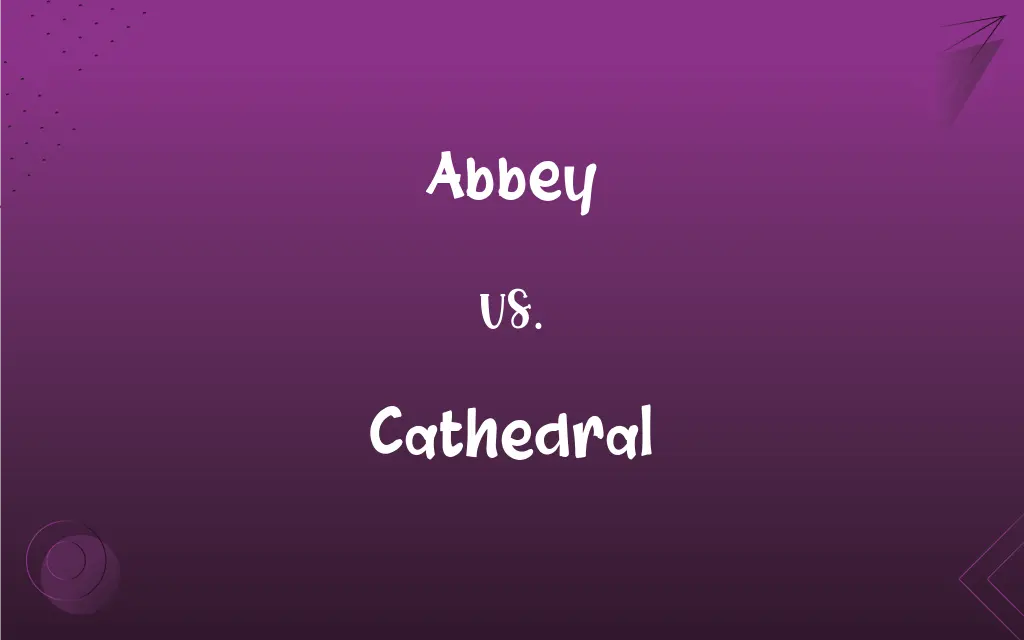Abbey vs. Cathedral: What's the Difference?
Edited by Aimie Carlson || By Janet White || Published on November 18, 2023
An "Abbey" is a monastery or convent overseen by an Abbot or Abbess, while a "Cathedral" is a Christian church housing a bishop's seat. Both are religious buildings with different functions.

Key Differences
An "Abbey" is typically associated with monastic communities, where monks or nuns live, work, and pray, under the leadership of an Abbot or Abbess. In contrast, a "Cathedral" is significant due to its function as the central church within a diocese, presided over by a bishop, serving as the administrative and spiritual headquarters.
An "Abbey" often includes living quarters, reflecting its purpose as a residence for members of religious orders committed to a life of devotion and service. A "Cathedral," however, is primarily a place of worship and may not include extensive living facilities, as it focuses on serving a larger lay community, not just clergy or religious orders.
The architecture of an "Abbey" can be expansive, including not only the church but also residential areas, farmlands, and often a school, emphasizing self-sufficiency. "Cathedrals" are known for their grandeur and architectural complexity, symbolizing the spiritual prominence and authority of the bishop and the church in a particular region.
"Abbeys" may or may not be open to the public, given their primary function as residences for monks or nuns leading contemplative lives. "Cathedrals," on the other hand, are pivotal centers for public worship, religious instruction, and the administration of sacraments, thereby generally open to the public for various services and events.
Both "Abbeys" and "Cathedrals" are steeped in history and tradition, often playing key roles in the cultural and spiritual life of their communities. While an "Abbey" focuses on the communal life of a religious order, a "Cathedral" serves a broader congregation, acting as a spiritual hub for a geographical area under a bishop's authority.
ADVERTISEMENT
Comparison Chart
Primary Function
Monastic living, prayer
Diocesan headquarters, public worship
Leadership
Abbot/Abbess
Bishop
Architectural Focus
Self-sufficiency, residential areas
Grandeur, bishop's seat
Accessibility
Limited public access
Open for public worship
Community Role
Religious order's communal life
Broader congregation's spiritual hub
ADVERTISEMENT
Abbey and Cathedral Definitions
Abbey
An Abbey is a place where a monastic community lives under the guidance of an Abbot or Abbess;
Life in the Abbey revolves around prayer, work, and communal living.
Cathedral
Cathedrals are often large, intricately designed buildings, renowned for their architectural beauty;
Visitors marveled at the Cathedral's stunning stained glass windows.
Abbey
An Abbey often holds significant historical value, reflecting centuries of religious practice;
The ruins of the medieval Abbey attracted historians and tourists alike.
Cathedral
A Cathedral is a church that serves as the seat of a bishop, central to a diocese;
The Cathedral towered over the city, a testament to its spiritual significance.
Abbey
An Abbey can be a center of education, where monks or nuns study and preserve knowledge;
The Abbey's library was renowned for its extensive collection of ancient manuscripts.
Cathedral
A Cathedral is a site for important religious ceremonies and events within a diocese;
The Cathedral was bustling as crowds gathered for the Easter service.
Abbey
An Abbey is a complex of buildings providing accommodation and a place of worship for a community of monks or nuns;
The ancient Abbey stood secluded in the countryside, providing a serene retreat for its residents.
Cathedral
A Cathedral serves as the administrative center for a bishop and his clergy;
Clergy members convened at the Cathedral for their annual meeting.
Abbey
While primarily a residence, an Abbey also serves as a place of worship for its community;
The choir's chants echoed through the Abbey's stone-walled chapel.
Cathedral
The principal church of a bishop's diocese, containing the episcopal throne.
Abbey
A monastery supervised by an abbot.
Cathedral
A large, important church.
Abbey
A convent supervised by an abbess.
Cathedral
Something that resembles a cathedral, as in grandeur or authority.
Abbey
A church that is or once was part of a monastery or convent.
Cathedral
Of, relating to, or containing a bishop's throne
A cathedral church.
Abbey
The office or dominion of an abbot or abbess.
Cathedral
Relating to or issuing from a chair of office or authority; authoritative.
Abbey
A monastery or society of people, secluded from the world and devoted to religion and celibacy, which is headed by an abbot or abbess; also, the monastic building or buildings.
From 1199 to 1203 William Punchard was the abbot of the abbey of Rievaulx, which was part of the Cistercian order of monks.
Cathedral
Of, relating to, or resembling a cathedral
Tall trees whose branches met to form cathedral arches over the path.
Abbey
The church of a monastery.
Cathedral
Relating to the throne or the see of a bishop.
Abbey
(British English) A residence that was previously an abbatial building.
Cathedral
The principal church of an archbishop's/bishop's archdiocese/diocese which contains an episcopal throne.
Abbey
A monastery or society of persons of either sex, secluded from the world and devoted to religion and celibacy; also, the monastic building or buildings.
Cathedral
(loosely or informally) A large or important church building.
Abbey
The church of a monastery.
Cathedral
(figurative) A large, impressive, lofty, and/or important building or place of some other kind.
Abbey
A church associated with a monastery or convent
Cathedral
A large buttressed structure built by certain termites.
Abbey
A convent ruled by an abbess
Cathedral
In certain right-wing conspiracy theories, the mainstream system or establishment of society, held to be liberal or leftist and to be working against the interests of the people or nation, which is both.
Abbey
A monastery ruled by an abbot
Cathedral
The principal church in a diocese, so called because in it the bishop has his official chair (Cathedra) or throne.
Cathedral
Pertaining to the head church of a diocese; as, a cathedral church; cathedral service.
Cathedral
Emanating from the chair of office, as of a pope or bishop; official; authoritative.
Now, what solemnity can be more required for the pope to make a cathedral determination of an article!
Cathedral
Resembling the aisles of a cathedral; as, cathedral walks.
Cathedral
Any large and important church
Cathedral
The principal Christian church building of a bishop's diocese
Cathedral
Relating to or containing or issuing from a bishop's office or throne;
A cathedral church
Cathedral
Beyond its religious functions, a Cathedral often stands as a cultural landmark;
The Cathedral's music concerts drew audiences from far beyond the city.
FAQs
Is every large church a Cathedral?
No, a Cathedral is specifically the church where a bishop's seat is located.
Can you visit an Abbey?
Some Abbeys allow visitors, but it varies, especially for those with active monastic communities.
Are all Cathedrals Catholic?
No, Cathedrals are found in many Christian denominations, not just the Catholic Church.
What do people do in an Abbey?
Residents of an Abbey, usually monks or nuns, engage in prayer, work, and communal living.
How old is the concept of an Abbey?
The concept dates back to early Christian monasticism, around the 4th century.
Can any church become an Abbey?
No, an Abbey specifically refers to a church that's part of a monastery or convent.
Can services be held in a Cathedral?
Yes, Cathedrals regularly host religious services and ceremonies.
How do Cathedrals get their name?
The term originates from 'cathedra,' Latin for 'seat,' referring to the bishop's seat.
What's the leadership structure in an Abbey?
An Abbey is led by an Abbot or Abbess, overseeing the monastic community.
What role does a bishop play in a Cathedral?
The bishop oversees the spiritual and administrative duties of the diocese from the Cathedral.
Why are Cathedrals important?
They're important for religious worship, ceremonies, and as the administrative center for a diocese.
What makes a Cathedral significant in a city?
Its role as a spiritual, cultural, and historical landmark, as well as its architectural significance.
Are there still functioning Abbeys today?
Yes, many Abbeys still house active religious communities.
Do all cities have a Cathedral?
No, only cities with a bishop's seat have a Cathedral.
Can an Abbey exist without a church?
Typically, no, as the church is central to the monastic life in an Abbey.
Are Abbeys self-sufficient?
Many historical Abbeys were designed for self-sufficiency, but it varies today.
Is an Abbey only for a specific religion?
Abbeys are associated with Christian monasticism, both Catholic and Anglican.
What's the difference between an Abbey and a priory?
An Abbey is led by an Abbot or Abbess, while a priory is led by a prior or prioress, often smaller.
Can a Cathedral belong to any Christian denomination?
Yes, the term 'Cathedral' is used across many Christian denominations.
Are Cathedrals built in a specific architectural style?
No, Cathedrals have been built in various styles throughout history, reflecting their eras.
About Author
Written by
Janet WhiteJanet White has been an esteemed writer and blogger for Difference Wiki. Holding a Master's degree in Science and Medical Journalism from the prestigious Boston University, she has consistently demonstrated her expertise and passion for her field. When she's not immersed in her work, Janet relishes her time exercising, delving into a good book, and cherishing moments with friends and family.
Edited by
Aimie CarlsonAimie Carlson, holding a master's degree in English literature, is a fervent English language enthusiast. She lends her writing talents to Difference Wiki, a prominent website that specializes in comparisons, offering readers insightful analyses that both captivate and inform.






































































